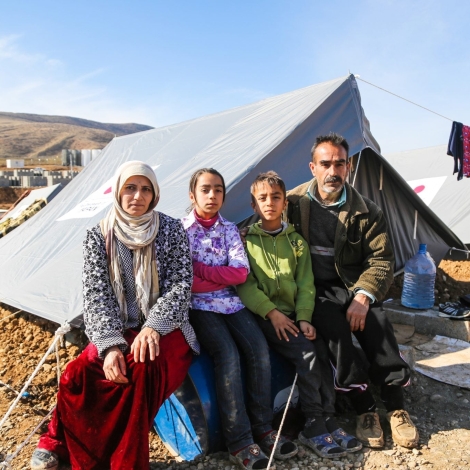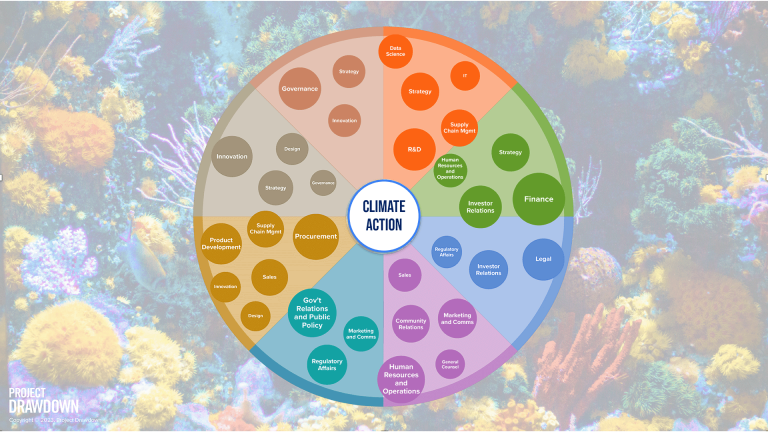The New York Times columnist Thomas Friedman draws a line that he sees from a changing climate to drought in Syria to the country’s civil war and refugee crisis. The fighters were motivated by poor policy decisions that siphoned off the drought-scarce water from small farms to large, Mr. Friedman writes. Syria may be just one example among several climate-exacerbated refugee crises explored in the Years of Living Dangerously documentary television show, in which Mr. Friedman took part.
The solution to refugee crises is counter-intuitive, but it’s action against climate change, says Joe Speicher, executive director of the Autodesk Foundation. Asked about its work in design for global development, the foundation offered two essays Mr. Speicher has written, both about climate change. The link between climate, poverty and refugees may not be obvious, but Mr. Speicher explains in Medium.
The US Department of Defense has acknowledged the increased risk of conflict due to climate change and there’s evidence to suggest that the Syrian conflict was sparked by droughts amplified by climate change. Strides are being taken to mitigate the situation. The UN’s Paris Agreement has created a task force on human displacement and we’re already resettling climate refugees in the US.
There are an estimated 65 million refugees worldwide and the impacts of a changing climate will only increase that number. This is driven by rising sea levels, proliferation of extreme weather events, increasing pressure on food and water resources and ultimately, reshaping the landscape of human habitable zones. Approximately 180–500 million people are at risk for continuous flooding and rising sea levels due to climate change.
While there are many drivers of forced migration — political instability, poverty, conflict, etc. — climate change either exacerbates or is an underlying cause of what contributes to the refugee crisis, and it’s an opportunity where we can take action. This is as empowering as it is daunting.
Concrete examples of creative design initiatives and public-private partnerships illustrate options available for curbing the effects of climate change. Mr. Speicher mentions US programs to improve climate resiliency in two coastal cities, New York and San Francisco. After Superstorm Sandy flooded parts of New York and other communities on the US East Coast, the Rebuild by Design program fielded ideas and invested in plans to strengthen the city against future storms. And in the Bay Area, Resilience by Design fostered solutions to protect the coast against slowly rising sea levels.
Ideas include energy infrastructure that can operate independently even if neighboring power plants go offline, and investment in green spaces that can absorb flood water and recharge aquifers to cushion against drought. Design teams in the Bay Area are employing digital tools to pinpoint the communities that might be vulnerable to rising sea levels and climate-change inflicted weather. Josh Bradt at the San Francisco Estuary Partnership explains.
This year the Trust for Public Land partnered with the City of Richmond, Contra Costa County, and local advisors to develop Climate Smart Cities: Richmond, a queryable GIS-based green infrastructure planning tool that locates zones of various climate and community vulnerability concerns around the principles of “connect, cool, absorb, and protect.” The San Francisco Estuary Institute (SFEI) completed its online Resiliency Atlas, which includes an “Interactive Map” tab that displays the full inventory of all frontline sea level rise barriers ringing the Bay.
Mr. Speicher calls these “lighthouse examples” that will “pave the way for more investment in resilient climate infrastructure and ultimately, demonstrate that an ounce of prevention will save us from massive coastal migrations, with millions of forced migrants and stranded assets in coastal cities.”
Effective action against changing climates requires investment in research and development. But, as Mr. Speicher points out, only 3.2 percent of the nearly (USD) $2.7 billion spent annually on renewable energy went to R&D. “As my colleague Larry Kramer recently argued, foundations and funders must “build the infrastructure needed to grow and sustain a flourishing impact investing sector,” which includes clean technology,” Mr. Speicher writes in the Stanford Social Innovation Review. He continues.
Fortunately, motivated investors and philanthropists have started to build a funding framework for businesses creating innovative climate solutions. Bill Gates, for example, spearheaded the Breakthrough Energy Coalition, bringing together many household-name billionaires to commit $1 billion a year to R&D over the next 10 years via the Breakthrough Energy Ventures (BEV) fund. Organizations such as the PRIME Coalition are facilitating investments in unproven but potentially transformative emissions-reduction technologies.
The problem presents opportunities to entrepreneurs, Mr. Speicher says.
The enterprising entrepreneurs, engineers, and designers coming up with the big ideas are working in fields as varied as urban mobility, the built environment, and carbon sequestration. However, three primary areas require the most research, development, and deployment:
- Energy generation. This incudes all modes of creating energy, including coal, oil, and gas. The cleaner generation methods include nuclear, wind, solar, geothermal, and hydropower. Innovation in this space tends to be incremental, such as improvement in wind-turbine efficiency, but we need continued research into tidal power, molten salt, and even piezoelectric floorboards that store the kinetic energy of footsteps.
- Energy distribution and transmission. Getting power from source to consumer is both a hardware and a software challenge. Balancing the supply and demand of disparate power grids requires that we have both data and new connectivity. The few grids that are connected are not linked efficiently, resulting in a lot of lost energy. Organizations such as Opus One and Varentec are tackling data challenges, while public utilities like those in China are investing in new transmission capabilities.
- Energy storage. This poses the most challenging and most promising opportunity; developing a sustainable battery-storage technology is mostly a chemistry and materials problem. It’s telling that the Lawrence Berkeley National Laboratory is building a materials library that explores chemistry via properties—electrical, mechanical, energy storage capacity, and so forth. As the search for the next battery breakthrough beyond lithium ion continues in myriad directions, advances in infinite computing have greatly advanced understanding about energy storage materials.
While entrepreneurs and others will need financial investment to conduct the necessary R&D, money may not be enough. “For entrepreneurs, the expertise, networking, and intellectual capital that incubators and foundations provide often accounts for equal or greater value. It’s time to build a more effective ecosystem of support and expand it as quickly as possible,” Mr. Speicher writes.
Climate change solutions may diffuse and even prevent future refugee crises, but today’s refugees need immediate solutions. They need housing. Companies such as Autodesk and Ikea are responding with software and design support, Mr. Speicher says.
“Autodesk provides software and services to The UN High Commission for Refugees’ (UNHCR’s) settlement team to design and build refugee camps faster and better. Together, we’re improving the refugee experience, and allowing for resources to be devoted to issues like relocation and resettlement.
“Our partners over at the IKEA Foundation are pioneering a number of initiatives supporting refugees currently in settlements, including better shelters and providing work to Syrian refugees.”
That may be inspiring to hear, but in a business world popularly thought to be obsessed with the bottom line, why does climate change matter? And where’s the profit in helping refugees? Mr. Speicher doesn’t dive into it, but he touches on a concept that seems to be gaining traction. “If enough individuals, cities and corporations, recognize that a healthy and prosperous society is good for business, then we can solve the refugee crisis,” he writes.

